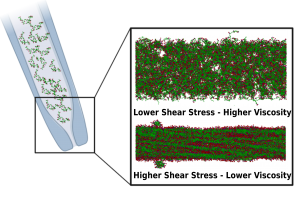Printing fuel cell membranes: Simulations of shear thinning in Nafion

Fuel cells offer a promising energy generation alternative for a wide range of technologies thanks to their ecological friendliness and unparalleled efficiency. At their heart lies the proton exchange membrane, the most important component. These components are created through the use of printing techniques, using polymer inks, with the most widely used material being Nafion. The physicochemical properties of the ink, such as its viscosity under shear, affect the properties of the finished product.
In this work researchers from the MBM group employ coarse-grained Molecular Dynamics Simulations to model the effects of shear flow on Nafion inks and how it affects their viscosity under shear. We shed light to the mechanism behind the shear-thinning effect that these inks exhibit under flow, showing that it is due to the longitudinal alignment of the Nafion strands along the flow direction.
Check out our paper: Longitudinal strand ordering leads to shear thinning in Nafion
Nicholas Michelarakis, Florian Franz, Konstantinos Gkagkas and Frauke Gräter
Physical Chemistry Chemical Physics
About HITS
HITS, the Heidelberg Institute for Theoretical Studies, was established in 2010 by physicist and SAP co-founder Klaus Tschira (1940-2015) and the Klaus Tschira Foundation as a private, non-profit research institute. HITS conducts basic research in the natural, mathematical, and computer sciences. Major research directions include complex simulations across scales, making sense of data, and enabling science via computational research. Application areas range from molecular biology to astrophysics. An essential characteristic of the Institute is interdisciplinarity, implemented in numerous cross-group and cross-disciplinary projects. The base funding of HITS is provided by the Klaus Tschira Foundation.